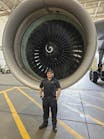All fleet aircraft operators fly with the same basic business rule in mind – an aircraft sitting on the ground because of maintenance requirements generates no revenue (commercial) and detracts from overall mission readiness (military).
Driven by ever-changing business models, global competition, high fuel costs and other unavoidable doing-business costs, fleet aircraft operators (both commercial and military) have developed a simple business strategy – control operating costs across the broad spectrum of the aircraft maintenance cycle by implementing processes designed to mitigate economic fluctuations.
MRO benefits and savings
Many fleet aircraft operators have realized some value and savings by implementing in-house maintenance, repair and overhaul (MRO) profit centers and/or by outsourcing their aircraft maintenance activities to established MROs. In turn, these MROs are increasingly applying Lean/Six Sigma principles and techniques to their operations to achieve dramatic and sustainable performance improvements.
Unfortunately, most MROs never realize peak effectiveness from these initiatives because they have failed to properly support them with an information technology (IT) solution that provides the broad visibility and effective data needed for true knowledge-based decisions.
Today, MRO operations account for 15 to 18 percent of the fleet aircraft operator’s total operating costs. Aircraft undergoing scheduled-maintenance actions, or aircraft delayed from being returned to service because of scheduled-maintenance actions, also create the need for additional capital expenditures for the spare aircraft needed to meet flight-dispatch schedules. The significance of these costs highlights the MRO industry as a key business area for targeted transformation.
“Lean MRO,” in conjunction with an optimized maintenance program, enables MROs to eliminate nonproductive or unnecessary tasks from their process-event critical paths, improve maintenance team performance, increase the yield of scheduled maintenance actions, and increase supply chain effectiveness. With these enhancements, maintenance teams can maximize information re-use, manage the complexity arising from asset variation, and reduce the time spent performing tangential tasks like information searches and data downloads.
When properly implemented, lean with Six Sigma helps reduce and eliminate the root causes of defects and unwanted process variability. When employed together, the following Lean/Six Sigma principles have the potential to generate significant performance improvements:
• Define value from the customer's perspective
• Clearly identify value streams in business processes
• Execute work assignments to optimize value
• Assure that every process adds value
• Remove obstacles to value creation
• Continuously reduce or eliminate waste
• Reduce process variability; focus on data and measurements
• Develop a culture intolerant of waste and defects
• Involve every employee in continuous improvement
Performance improvements
Lean/Six Sigma-enhanced production processes provide opportunities to protect future revenues through true competitiveness. Industry statistics suggest that with lean/Six Sigma, MROs can achieve extraordinary performance improvements. Over a three- to five-year period, it is not uncommon to realize significant savings in: labor productivity, inventory reduction, defect reduction, lead time reduction, hangar or work space reduction, increased capacity, and on-time delivery improvements.
In addition to enhanced processes, Lean/Six Sigma-qualified aviation-maintenance subject matter experts provide valuable, enterprisewide insights into maintenance programs and schedules. These individuals possess the background and experience to:
• Evaluate and redesign fleet maintenance programs or schedules to eliminate wasted efforts arising from poorly sequenced, too-frequent or unnecessary tasks
• Assess planning and proffer advice on optimizing check packages to increase production velocity and flexibility while reducing process complexity
• Help implement a adaptable system response to an FAA continuing analysis and surveillance system (CASS)
Culture change
To achieve the success that will only come with process optimizations and culture changes, MROs must implement the IT designed specifically to support lean MRO operations. Today, success in MRO operations is no longer about simply turning wrenches. It is now all about the tooling that provides reliable, just-in-time information to MRO decision makers.
Software solutions
Any suite of MRO software solutions should provide maintenance and engineering organizations with the planning, execution, analysis, and reporting solutions required to drive the following Lean/Six Sigma initiatives:
• Detailed event planning and execution for heavy, shop, light, and line maintenance actions
• Robust data capture, analysis and reporting for metrics-driven continuous improvements
• Optimal task assignments and material tool allocations
• Real-time status internal/external communications
• Maximization of the mechanic’s time on assigned tasks at workstations
• Integrated analysis of reliability information from aircraft, legacy and execution information
(chart)
A common problem in achieving a truly Lean MRO operation is a less-than-comprehensive/complete lean transformation. Even though MROs spend millions of dollars to transform their facilities into lean machines capable of collecting significant amounts of data, many lean/Six Sigma efforts fail because of a lack of effective IT integration throughout the operation.
In other words, ineffective and nonuse of IT systems to enable and support lean methodologies are the two main reasons for lean-implementation failure.
An effective lean IT solution is integral to capturing, managing, and accessing the comprehensive and highly accurate set of information applicable to lean MRO processes and assets. Once this information is collected, it must provide enterprise leadership with the core knowledge needed for effective decision support across the entire product lifecycle. This knowledge can then be leveraged in work flow-driven processes which, in turn, can be tightly focused to achieve metrics-driven lean/Six Sigma MRO objectives.
In closing, Lean MRO is a holistic, comprehensive, enterprisewide program designed to be integrated into the MRO’s core strategy as an aid to operational transformation. The Lean MRO’s IT solution enables MRO/Six Sigma strategies by doing all of the following things very well: Ensure repeatable processes and systematically provide micro visibility to movement of assets (including technicians) in a cost-effective manner; guarantees both reliability and readiness; and reduce turnaround time (TAT) and cycle time with accurate forecasting of resources by providing just-in-time knowledge.
Dinakara Nagalla is chief executive officer and president from EmpowerMX. EmpowerMX provides aircraft maintenance software and consulting services to the air transport industry. For more information visit www.empowermx.com.



